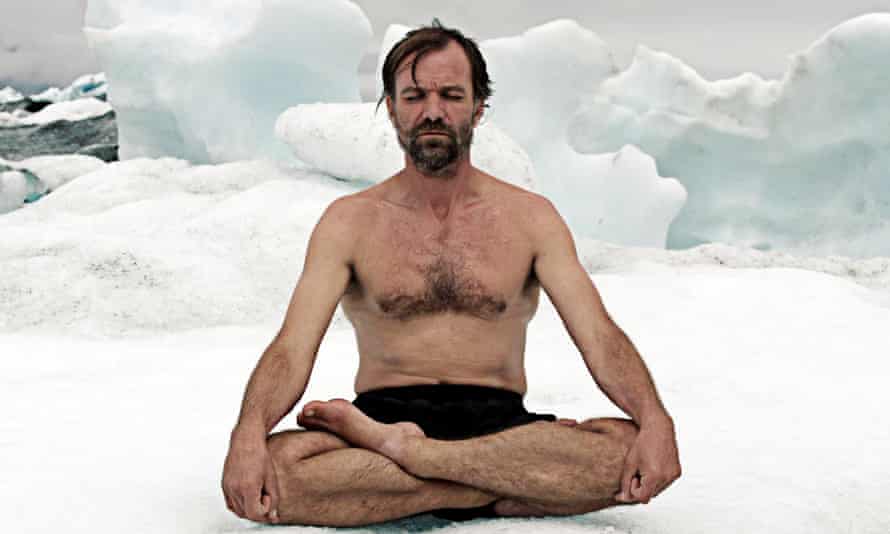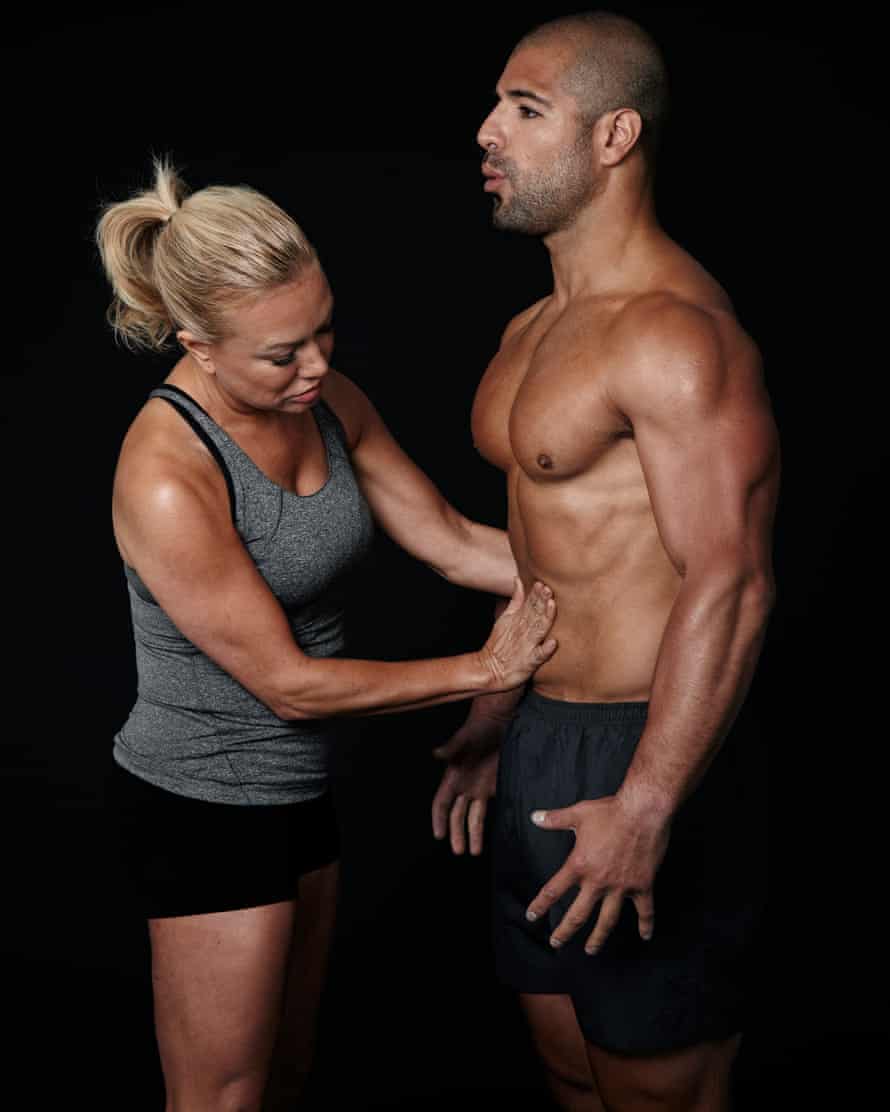by Richard Godwin: You do it more than 23,000 times a day, but are you breathing properly? From a rebirthing session to holotropic breathwork, Richard Godwin inhales the latest wellness craze…
Are you sitting comfortably? Airways clear, back straight, no respiratory conditions? OK. Take a series of short, deep breaths. Activate your diaphragm, pull the air right down into your belly, let the chest fall. Repeat 30-40 times. Feeling a little floaty? Fingers tingling? Don’t worry. It’s just oxygen saturating your cells.
Now take a big breath, then expel all the air from your lungs and hold it. Relax, you’ll be fine. (As long as you’re not doing this in a swimming pool.) That slight feeling of panic? It’s nothing to worry about. You might be surprised how long you can push it before you have to take a huge gasp.
After three attempts, I managed three minutes 23 seconds of not breathing. The person who formulated this exercise, Dutch endurance specialist and multiple world record holder Wim Hof, 59, has trained himself to go up to six or seven minutes. He claims that by performing this exercise daily (along with a regimen of cold showers and meditation), we can help treat a whole suite of conditions and diseases, from depression to arthritis. “It’s so simple,” he tells me. “That’s why people overlook it. They stay in their brains thinking, ‘This cannot be so simple.’ But it is!”
While Hof may be the most eccentric person to tout breath as a panacea for the 21st century, he is not alone. I first started noticing how fashionable breathing had become when I moved to Los Angeles in 2016. One of the first people I met, an English film producer, had just had the word “BREATHE” tattooed on her wrist. New friends told me about conscious breathwork circles and breathing re-education classes. Hardcore gym types talked excitedly about breathing as a “remote control for the brain”. Even Hillary Clinton claimed, in her book What Happened, that yogic alternate-nostril breathing was what helped her get over losing the presidential election to Donald Trump: “Breathing deeply from your diaphragm, place your right thumb on your right nostril and your ring and little fingers on your left…” and so on.
Now breathing classes and retreats have reached Britain, too: the Transformational Breath Foundation UK lists events all over the country, promising that “you’ll access the full potential of your breathing system”. “Breathfulness” is touted as the new mindfulness (though one attendee of a recent session in London described it as “yoga without the yoga”). Breathing: once you start noticing it, everyone’s doing it.
And, in some ways, it’s inevitable. A whole self-care industry has made us doubt everything we do naturally – eat, exercise, sleep – and breathing is at the heart of it all. Since you do it around 16 times a minute, 960 times an hour and 23,040 times a day, there’s an awful lot of room for improvement.
Still sitting comfortably? You can breathe normally now.
“Breath has been ignored by the general public,” Dr Belisa Vranich says. I suppose she would say that: a child psychologist by training, she now works at the Ash Center in New York, an “integrative and functional medicine” practice, where she teaches breathing techniques to firefighters, police officers and soldiers to help them manage stress. She now has her sights on the general breathing public. “Pulmonologists have been looking at severe dysfunction. Yogis have been looking at pranayama. But no one has been thinking of the average person like you and me. People are realising that they’ve been completed neglected.”
She has developed a breathing IQ test, designed to measure both lung capacity and breathing style. In her 2017 book Breathe, she asks further questions: do you sit in front of a computer all day? Did you experience trauma, fear or anxiety as a child? She thinks 95% of us are breathing in a way that is “biomechanically unsound”, which is to say, we’re breathing “vertically” (short, shallow, stressed-out breaths up in our chests) as opposed to “horizontally” (long, expansive, restful breaths that make full use of our lower lung capacity). “Most people have no idea where their lungs are,” she says. She tells me to spread my fingers between my nipples and my belly button. “In the middle is where the biggest part of your lungs are. Not up in your collar bones.”
She tells a respiratory version of The Fall; humans used to breathe correctly. When a three-year-old breathes, their tummy goes in and out. Same with animals. But at a certain point we started breathing “vertically”. That’s how we’re designed to breathe when we face genuinely stressful situations – but not, say, when our phone pings 150 times a day. The way she describes it, we have been hit by a “perfect storm”; not only are we much more sedentary, we’re also constantly responding to digital technology, a respiratory disaster. “When you’re looking at these screens, your breathing changes. You’re like an animal in stalking mode. And, if you notice, you’re spending all day taking incredibly small breaths. The only time you’re really breathing is when you take a big, expansive sigh.” Breathing properly, she maintains, is the single most important intervention you can make for your own health. Cheap, too.
Breathing is automatic and not automatic at the same time. Respiratory function is controlled in the brain stem, the part of the brain that controls the basic things that keep us alive, like a heartbeat. You still breathe when you’re unconscious, asleep or anaesthetised. But, in some ways, it’s closer to somatic functions (such as walking) than autonomic, involuntary functions (such as sweating). You don’t have to think about each step you take, you just head somewhere. Your brain automatically adjusts your steps, just as your brain will occasionally insert a sigh when it needs more oxygen. But you can also decide to hold your breath, hyperventilate or, as the more out-there breathwork practitioners promise, use your breath “to journey between the conscious and unconscious mind”.
When I first became conscious of my breathing, aged five or so – about the time Dr Vranich thinks we start doing it wrong – I remember experiencing a childhood version of an existential crisis. What if I forget to breathe? Sometimes, I’d catch myself not breathing and worry. Not without reason: I used to faint frequently due to a lack of oxygen in the brain. But somehow I went through the next few decades barely thinking about it, until one Sunday morning last year when I went to report on a communal exercise class on a basketball court in Runyon Canyon, LA, hosted by a group of wellness bros who call themselves the Wildfire Initiative.
I was expecting a gruelling session of weights, cardio, humiliation. In fact, it was quite pleasant. The instructor, Bryan Ellis, a singer-songwriter with a face tattoo and a messianic demeanour, told us that since he was “lazy as fuck”, he had finessed his exercise routines right down to the two essentials: walking and breathing. He asked us to lie down and put us through a breathing exercise in which we hyperventilated, then held our collective breath.
“I want you to notice that point of anxiety,” Ellis said as we lay under the sun. “Because that feeling of anxiety we get when we realise we need more air is very similar to that feeling of anxiety we get 100 times a day from the littlest thing. This feeling is natural in life-or-death situations, like when we can’t breathe. Not when our phone has died.” I expected to faint, but I felt fantastic. As we hiked up the canyon, Ellis told me that he can hold his breath for six minutes, despite smoking 10 cigarettes a day.

I later discovered that his teachings are a loosely modified version of Wim Hof’s patented Method (known as WHM), which has gained a cult following among bodybuilders, athletes and celebrities, including Oprah Winfrey and Orlando Bloom. Hof is also known as the Ice Man, which comes from his penchant for encasing himself in ice, swimming under bits of the Arctic and climbing up mountains in shorts. (He made it up Kilimanjaro, but didn’t quite manage Everest.) He holds 26 world records for withstanding extreme temperatures, partly thanks to his breathing technique, and runs retreats in Holland, Poland and Spain; he also sells online courses, while giving away the basics free in his app.
“The autonomic nervous system! The endocrine system! The lymphatic system! The immune system! The vascular system!” he declaims when I Skype him in Holland. “According to science, humans couldn’t actively influence any of these. But we have shown that you can tap into them.” Just by breathing? “Yes! That’s why we made a T-shirt that says: ‘BREATHE MOTHERFUCKER!’” He bursts out laughing. “It’s so good, because it’s so simple!”
His thesis is that modern humans live in a comfort zone that’s slowly killing us (and also making us fat: you burn many more calories in the cold). Our ancestors used to be fine mooching around the tundra in loincloths. But as humans have learned to control our environments – with central heating, insulation, coats and so on – we are losing our ability to respond to nature.
There’s no doubt Hof is a peculiar individual. But while he is what you might call “conspiracy minded”, he is careful not to position his method as any kind of substitute for conventional medicine. And there is some evidence that he may be on to something. The American author Scott Carney set out to debunk Hof’s methods for his 2017 book What Doesn’t Kill Us, but ended up broadly convinced. The most credible evidence came in 2014, when a team of researchers at Radboud University in Nijmegen in the Netherlands studied 12 subjects who had followed the Wim Hof Method and found they had an increased ability to resist infection and fight inflammation. The researchers concluded that this had “important implications” for the treatment of diseases that involve excessive inflammation, especially autoimmune diseases. It was a small sample, and it remains to be seen whether it’s the cold exposure or the breathing that’s the crucial factor, but there are a number of further medical trials under way across the world.
Still, the notion that breathing is good for you is one of the least controversial things you could say about the human body . “All chronic pain, suffering, and disease are caused by a lack of oxygen at the cell level,” wrote Dr Arthur C Guyton in his Textbook Of Medical Physiology in 1956, one of the world’s most widely used medical primers. “Proper breathing nourishes the cells of the body with oxygen and optimises the functioning of the body on all levels.” Studies have shown that conscious breathing exercises such as the 4-7-8 (breathe in for four, hold for seven, out for eight) are beneficial for a wide variety of conditions. Conscious breathing activates the body’s relaxation response, which in turn reduces blood pressure, which in turn lowers the risk of stroke and improves cardiovascular health. It’s also good for digestion and general immunity, both of which are impaired by stress. Similar techniques are at the heart of hypnobirthing classes, which are becoming increasingly popular. As long as you don’t expect breathing alone to cure you, it probably won’t hurt you.
A little more on the edge are the consciousness-altering breathing techniques adapted from various Buddhist practices by the psychedelic pioneer Stanislav Grof at the Esalen Institute in California in the 1960s – now seeing a comeback as part of a wider psychedelic renaissance. Essentially, Grof learned how to induce “natural” psychedelic states through controlled hyperventilation. The author Michael Pollan tries out one such technique, holotropic breathwork, in his new book How To Change Your Mind, and pictures himself on a horse, galloping through a forest, “absorbing the animal’s power”, before returning to normal consciousness to find his heartbeat is all over the place. Holotropic breathwork is not recommended if you have prior heart conditions, as Pollan had. But that hasn’t stopped it gaining popularity in Hollywood, Silicon Valley and beyond.
A British entrepreneur, Poppy Jamie, 28, tells me she was so inspired by the holotropic breathing workshop she attended in LA that she decided to reassess her whole career. “We were in this room of 40 people, all hyperoxygenated. And it was such a release, I cried for two hours afterwards.”
She decided to “pivot” away from her online accessories brand and concentrate on her wellness app, Happy Not Perfect, which offers a series of exercises and techniques designed to help stressed-out young millennials cope with their hyperconnected lives – a tech-on-tech solution. When she conducted focus groups, Jamie says, the breathing exercises were the most popular part of the app: “My generation found it really difficult to ‘think of nothing’ and ‘meditate’, but breathwork was something they could focus on and feel the physical effects of immediately.” She sees it as being a bit like yoga or mindfulness, but without the complicated bits. “I think more and more people need to hear about breathing. It grounds you in the present moment. In my dreams, there would be a breathing centre on every street corner.”

Intrigued, I visit a breathwork practitioner named Federica Ferro at her home in London. She used to work in fashion in Milan and New York, but became disillusioned. On holiday in Mykonos, she decided to submit to a “rebirthing” at the hands of Katia Boustani, the founder of an initiative called Global Breathing Awareness. This is described as a “safe and natural breathing method which connects us with our subconscious mind”. The idea is not to pause between exhaling and inhaling, so every time you breathe out you cut it a little short and breathe in again. This induces a trance-like state in which the conscious mind quietens down, apparently allowing the subconscious to do a little rewiring.
Her own first experience was life-changing. “At some point, everything that was in my mind started to dissolve, almost like I was detaching from my thoughts,” Ferro says. “Then I started to laugh. It came up through me and I felt this spiritual liberation. After a while, I saw galaxies, darkness, stars, and felt this sense of belonging. I had this incredible peace of mind. But it wasn’t just my mind. It was my body, my breath, all of my dimensions: everything. And it lasted for quite a while.” When she emerged an hour later, she tried to explain what had happened. “Katia told me, ‘Well, you’ve had what we call a cosmic orgasm.’” Ferro decided to become an instructor herself, performing rebirthing work for private clients at her home.
“So what do you want from your rebirthing session?” she asks me as I lie on her bedroom floor. A cosmic orgasm? Instead, I get a sort of waking trance. After a few preliminary deep breaths, Ferro instructs me to breathe in and out on her instruction, establishing a deliberate rhythm. “When you inhale, you can think you’re breathing in everything you need: love, compassion… The exhale corresponds to the surrender, the letting go of everything you don’t need.”
At first, I find it sort of stressful. It takes a lot of effort to breathe in and out to someone else’s command. But before long, my mind wanders away from my tangle of deadlines and errands to some other zone. Time bends a little. I emerge after what feels like 10 minutes but is actually an hour. I feel refreshed. Clear-headed. I didn’t quite experience what she experienced, but perhaps the cosmos wasn’t willing.
Ferro writes me a list of things I should take from the experience: “I now give myself permission to prosper and flourish in all areas of my life. It is safe to feel all my emotion and let my heart guide me.”
I’m not holding my breath.
How to breathe
Put one hand on your belly and one on your chest, between your collar bones. Breathe slowly and deeply from the diaphragm. Your belly should expand in an exaggerated way on the inhale, your top hand should be still. This is the sort of “horizontal” breath you should aim for.
Now do it “wrong” to feel the contrast. Breathe upwards into the chest, so your top hand moves but your bottom hand is still. This is the “vertical” breathing you should try to eliminate.
Exercise 1
Perch on the edge of a chair with your back straight. Breathe through your mouth. On the inhale, lean forward while expanding the belly. On the exhale, contract the belly as you lean back – breathe out until you are completely empty. Repeat 20 times. The movement should help situate the breath low in the body.
Exercise 2
Lie on your back and place a large book on your belly. Take a deep belly breath so it rises up in your peripheral vision. Repeat 50 times, adding heavier books. This will strengthen your core breathing muscles. Belisa Vranich
This Simple Breathing Trick Can Give You Better Orgasms
The Mystery Of The Female Orgasm
This Is The Main Reason Humans Crave Orgasms
The Clitoris Has 10,000 Nerve Endings

















































